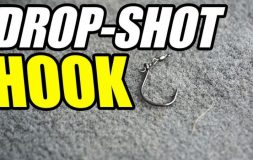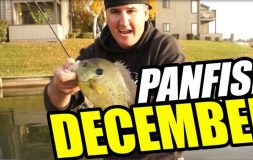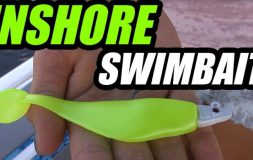Killer crankin’ for better bass!
There’s a KILLER on the loose!! Squarebill crankbaits typically only run 5 feet or less, but the Lake Lunker Killer Crank bangs around even deeper. Find out why Nick thinks this crank is built for big fish!!
* Transcript below:
Direct from the Smith Pier down here where we’re trying to catch some carp. Unfortunately things haven’t been seemed to be happening in the area. Although, we do have some local hobos over across the river over here trying to see what they can possibly catch too.
That’s a special boy. That there is a special boy. Did it go off? There’s a special boy.
Archbell. big, big, archbell. Hell yeah!
Hey, what’s up guys? Nick, the Informative Fisherman here, on behalf of Lucky Tackle Box. And today I get to introduce you guys to the Lake Lunker’s killer crank. This is a very unique little square bill. I normally compare things to like a 1.5 size, or a 2.5 size, and this comes in at 2 1/3 inches long. It says it dives three to five feet deep, but I was really getting about six or seven foot on 12 pound fluorocarbon. And the really cool part is, I’m going to show you this other bait up close. I kind of modified this Killer Crank into a coffin bill, where I was getting almost eight or nine feet out of it, and this thing is still kicking all over like a square bill. Very unique presentation, and it’s got something kind of cool. They say it’s their unique sound chamber. It is like a single knocker in that little square bill there. I’m under this theory, multiple rattles catches more fish, single knocker catches big fish. So let’s break this bad boy down.
Oh, God, yeah. A big one. No! Oh! He threw it!
Now, whether you got a bluegill pattern, or a shad pattern, I want to veer outside the norm right here. And I really want you to think about what a square bill’s ability is. A square bill is very audible. It’s noisy. It’s displacing a ton of water. It’s one of those dingier, dirty water killer type of baits because it appeals to the fishes lateral line, it appeals to the fishes senses and hearing. Real noisy. Real loud. Kicking all over the place.
So, let me tell you a little something else. A little belief I have in the square bill. I believe the square bill imitates a fish in stress mode. You know when you ever hook a bluegill, taking kids out to fish and that bluegill starts acting real erratic? And sometimes it just triggers an inactive bass to run up and grab that bluegill, though you’ve been fishing there all day long? My theory is a square bill is probably one of the best baits at triggering that instinctive action out of a largemouth bass to come and eat.
So, if you’re around shad, yeah you could match the hatch. If you’re around bluegill, it could match the hatch. If you got a craw pattern, you could match the hatch on craws. But a lot of the time it’s not necessarily about matching the hatch with the square bill. The one thing you gotta focus on with the square bill is getting it close to that bass. Getting it down in there and deflecting off of that concrete, deflecting off of the boulders, ripping it in and out of grass. You wanna be near them. For a square bill, they don’t like to travel far and get it, necessarily. They like it to be right there and just turn and pop! Smack it! They react to it.
So, at all times you need to be thinking, “How can I get this really close to that bass’s face?” You never want to be reeling too far above em. You never want to be too far outside that strike zone. You wanna make repeated casts to an area and try to deflect off everything you can and pop it in and out of everything you can to score those reaction strikes off a stress mode style bait like a square bill.
So when it comes to the equipment, I’m gonna throw the killer crank on. This is a lighter, smaller square bill, so the heaviest line I’m gonna throw it on is about 12 pound fluorocarbon. The reason I use fluorocarbon is that sensitivity, that low stretch. I’m gonna feel it when there’s grass on there and I need to pop it. I also want low stress for when I pop it, it can tear that grass free. And I also know when I’m making contact with those rocks or bumping into timber.
From there, I want a medium power bait casting rod. A lot of people don’t have a medium power, so what a lot of the guys do have is a medium power spinning rod. And that is also a good choice for the killer crank. You can bomb it out there. It’s a smaller crank. It has smaller treble hooks. It’s gonna hang onto em. You don’t really need to wrench em with a bait caster if you don’t have it, so you can throw it on that spinning rod with eight pound or ten pound fluorocarbon. The lightest line I go on a bait caster is ten pound fluorocarbon, and I’m able to get, probably, eight or nine feet of depth on that square bill right there, which is outstanding. There is very few square bills that can go that deep.
I do like a lot of cushion in the tip of my rod. This is a Stiks hybrid cast right here. This is a very light bait caster. This is one of the lightest one in the Stiks setup, and you can really launch that killer crank out there a long ways.
A fast reel isn’t necessary. Anything a six speed or up, that’s one revolution of the handle is six rotations of the spool, is gonna get you by just fine. You wanna remember you don’t want to wrench on them too hard with a smaller square bill like these. Take your time with them. When they get em, those smaller treble hooks are gonna penetrate in there deep. Don’t horse em. Take your time, and land some big fish on that puppy.
So, when am I gonna throw a bait like the killer crank? Low-light conditions, early morning, later evening, overcast days are gonna work well. This is going to make the fish want to run things down. Covering a lot of water, making long casts is gonna work. When the water is dingy is also a great time. Dingy and slick com, not so good. Dingy and ten-plus mile an hour wind is really good. Even if you have clear water, go to the lee side of the lake. That’s where the wind is blowing in. That’s gonna murky up a dirt line right there on those shallower shorelines. It’s gonna push plankton in there. Smaller bait fish are gonna come in there and feed on it, and that’s a perfect time to throw a killer crank bait like that right up in that windier shoreline and windier bank.
But with that lighter square bill you want to keep in mind to keep that wind to your side and slightly downwind of your target. To where you want to come up and you want that wind kind of blowing into your target zone to bomb that cast out there a little bit farther. Trying to cast this lighter one into the wind, you definitely want to throw it on a spinning rod. Low-light hours, windy days, dirtier water, but if it’s clean water, fish the lee side of the lake where that wind is blowing into it.
Targets that I’m gonna throw this around. Grass lines, little pockets up in the shorline. If I’m casting shallow, I’m gonna start with my rod tip high, and as it moves out away from the shoreline, I’m gonna lower my rod tip, trying to maintain contact with structure or cover, like I said. If it’s getting hung up in the grass, pop your rod tip up. Reel. You want to be consistently getting caught in that grass but you don’t want to dredge down into it. You wanna hang up, pop it, hang up, pop it. That’s gonna get you those reaction strikes for those bass that are hiding down there in the grass.
As the sun comes up in the middle of the day, it’s good to target shade lines or that grass, but normally a shade line where the sun’s coming over. Or maybe a rip rap rocky bank. Get down there and deflect it off those rocks. ‘Cause there’s gonna be shade pockets those fish are going to hide in. So it doesn’t necessarily have to be low light hours, but you can get in areas that are gonna have low light and little shade pockets. Whether that’s under trees, behind a grass line and the grass is creating shade for them, down in behind it, or along a rocky wall that’s going to have some bigger rocks with shade pockets down in there for them to hide and ambush on a bait like that.
I wanted to show you guys something here. I hit a rock, getting a little too anxious casting, and I chipped the corner. So what I did is I actually filed the corners off, which makes a coffin bill. A coffin bill’s in between a round bill and a square bill crank bait. A square bill gives you a ton of erratic action and it causes that wounded fish style reaction out of a bass. Versus a round bill can dive in a lot, lot deeper. So what this does, its kind of like the best of both worlds doing a coffin bill. Once I did this on this bait, with about 12 or 15 pound fluorocarbon versus stock, I was getting about an extra foot and a half of depth.
So, maybe you’re fishing a pond where you want to hit the rocks that are out there a little bit deeper, with this thinner plastic on here you can take a file and you can modify your square bill to make it run a little bit deeper and give you that coffin bill presentation. Which is gonna give those bass a different look in the area if your buddies are also out throwing that killer crank.
When comes to casting a smaller square bill like this, you’re gonna see a lot of guys that reel up to the tip and have their crank baits close. With a smaller square bill you want to leave out more line. What that’s gonna do is, when you build up for that big cast, it’s going to allow the rod to flex more, therefore you’ll get more range of motion in your cast.
So just a little flick like that. We’re looking at ninety-plus feet of water out there. This is all grass. But if it was rock, immediately what I would do if it was rock, I’d have my rod tip down. Any time I hit a rock I would stop reeling, hesitate for about a half a second, reel down again until I hit another rock, hesitate, let it come up, reel down again and hit the rock, reel down again and hit the rock. Pop, pop my rod tip. Pop, pop my rod tip. Hit the rock. And what that’s gonna do, it’s gonna cause a ton of erratic motion and you’re gonna get those reaction strikes out of those bass that won’t hit anything else but a square bill, forcing them to react.
In the sake of all grass like I have here, I’m gonna make that same cast. Let me clear that grass off that bait. I’m gonna make that same little cast out there. I’m gonna get it hung up in the grass and then I’m gonna go pop, pop with my rod tip up, reel down, hang in the grass, pop, pop, rod tip up, reel down and hang in the grass. And that’s that same principle. Those bass are hung up down there in the grass hiding as the sun comes up. When the sun’s down, low-light, those bass are generally on top or roaming. As that sun comes up, those bass are gonna pull down in the grass. When you hang in that grass, its right there next to their head. That pop, pop is gonna get them to react, they’re gonna shoot out and they’re gonna eat that square bill.
I’m Nick, the Informative Fisherman, and that’s the Lake Lunker’s killer crank. Remember guys, if you like this video, make sure to click that subscribe button, get that little bell notification, follow us on Instagram, Facebook, all the other social media channels at Lucky Tackle Box guys. We’ll see you next time, and best of fishing.










